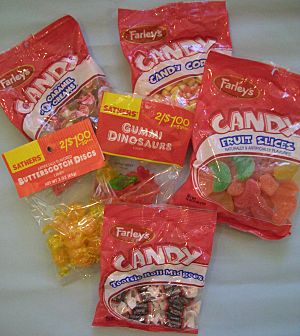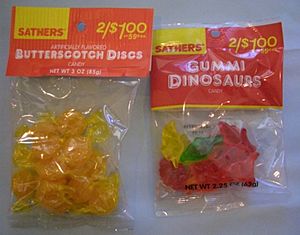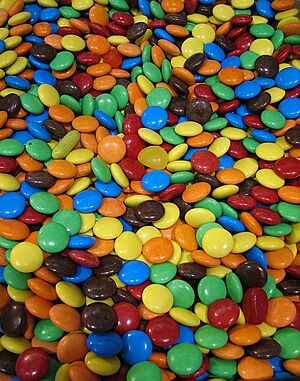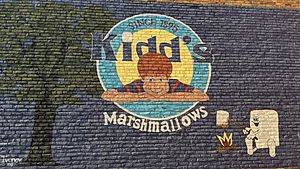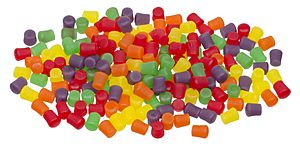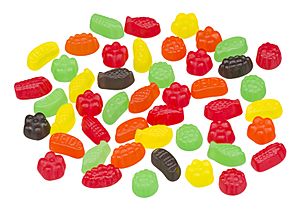- This page was last modified on 17 October 2025, at 10:18. Suggest an edit.
Farley's & Sathers Candy Company facts for kids
This page is about the candy manufacturer. For the British food manufacturing company, see Farley's.
Farley's & Sathers Candy Company was a big company that brought together many smaller candy brands and products. The candy world often has many companies with linked histories.
In 2002, a company called Catterton Partners created Farley's & Sathers Candy Company. They bought some brands and assets from the old Farley Foods Company and Sathers Candy Company, which were then owned by Kraft Foods.
Over the years, more brands and businesses joined Farley's & Sathers.
In 2012, the owners of Farley's & Sathers bought Ferrara Pan Candy Company. The owners kept control, and the company's name changed to Ferrara Candy.
Contents
- History of Candy Companies
- Ferrara Candy, formerly Farley's & Sathers, Today
- Ferrero Purchases Ferrara
History of Candy Companies
Many candy companies have joined together over time. The original Farley's and Sathers companies first combined under a company called Favorite Brands. Favorite Brands also included Dae Julie and Trolli.
Later, Favorite Brands was bought by Nabisco, which then merged with Kraft Foods.
When Kraft sold off some of its brands, Farley & Sathers became a new company. The North American Trolli business, which Kraft had kept, was later sold to the Wrigley Company. Wrigley then sold it to Farley & Sathers.
Many of these companies' stories are connected. For example, Sathers often bought bulk candy from Farley. Farley's growth was partly due to problems at E.J. Brach's, which later became part of Farley's and Sathers.
When Kraft sold Farley, it lost its fruit snack business but kept the Dae Julie gummy plant. Later, when Farley & Sathers bought Brach and Brock, it got a fruit snack business back. Over time, many factories and distribution centers were closed or combined.
Company Beginnings
Sathers' Story
John Sather, a grocer from Round Lake, Minnesota, started the Sather Company in 1936. He bought large amounts of cookies to sell to stores across southwestern Minnesota.
By the early 1960s, Sathers delivered products to five states in the Midwest. The company grew, adding a nut roasting operation in the 1960s. In 1967, Sathers started taking orders by phone, expanding its customer area to eleven Midwest states. This growth meant Sathers added more trucks to its delivery fleet.
Sathers mostly repackaged products. This means they bought candy in large amounts and put it into smaller bags for stores. One company Sathers bought from was Farley Candy Company. Many of its chocolate products came from Haviland Candy Company, a part of NECCO.
Sathers is known for creating "pegboard" or "hanging bag" candy. This is now a very common way to sell candy in stores. Another new idea was their phone-based ordering system. Their sales team had quit because of low pay and because they had to sell, deliver, and stock the candy themselves. Sathers' new system allowed customers to order by phone and then unpack and stock the shelves themselves.
The company kept growing. In 1972, Sathers started distributing products nationwide when it got half of the national Kmart business. When it bought Kitchen Fresh Company in 1983, Sathers got the rest of Kmart's national business. Sathers also bought Bayou Candy Division in 1985, and Powell's Candy Company and Northstar Candy Company in 1991.
Sathers then had three factories: a nut roasting plant in Chattanooga, Tennessee, and two candy plants in Hopkins, Minnesota, and New Orleans, Louisiana. They also had two distribution centers.
Farley's Story
In 1870, Gunther Farley and his two brothers started Gunther Chocolate Company. This company later joined with another smaller candy company owned by the Farley family in 1891, becoming Farley Candy Company.
As it grew, Farley Candy moved its operations several times in Chicago, finally moving to Skokie, Illinois in 1951. Preston Farley, a third-generation family member, managed the company until 1968. That year, Preston Farley sold most of the company to Raymond Underwood.
During Preston Farley's and Underwood's time, Farley mostly made jell and other products using starch moguls. Farley also made cinnamon imperials, which are panned candies, and hard candies like sanded lemon hard candy. Preston Farley invented the Farley Jet Cooker, a machine still used today to make candy.
In 1974, William Ellis bought 100% of the company. That same year, he bought Lakeside Candy Company, also known as Zion Candy, which made individually wrapped hard candies like starlight mints and butterscotches.
In 1981, Farley was operating from its plants in Skokie and Zion, Illinois. A third plant was added, a 103,000-square-foot (9,600 m2) building bought from Peter Paul-Cadbury. This plant became Farley Candy Company's main chocolate factory.
In 1985, Farley bought a large, empty 265,000-square-foot (24,600 m2) warehouse in Chicago and turned it into a candy factory. This big plant became Farley's main manufacturing facility in June 1986. It was mostly used to make a new type of candy: Fruit snacks, and later, Fruit Rolls. These were made using the same machines as gummy candies, with real fruit juice and added vitamins. As gummy candies became more popular, this plant also made those products.
In 1988, Farley took over Jaffe Candy in Compton, California, creating a 50,000-square-foot (4,600 m2) packaging and distribution center on the West Coast. Also in 1988, Farley leased a 253,000-square-foot (23,500 m2) warehouse in Bedford Park, Illinois. With four candy factories and two distribution centers, Farley Candy Company was the second largest bagged candy maker in the U.S. and the largest maker of private label candies.
In 1990, Farley bought a 142,000-square-foot (13,200 m2) former E.J. Brach's factory in Melrose Park, Illinois. This plant made many products, especially hard candies. It eventually replaced the Zion, Illinois plant, bringing production closer to the company's main warehouse. One key product made here was Starlight Mints, which were cheaper to make than those from competitors.
In 1993, Farley needed more space. The company, which had changed its name to Farley Foods USA, bought a 144,000-square-foot (13,400 m2) factory in Oklahoma City, Oklahoma and a 100,000-square-foot (9,300 m2) warehouse in Moore, Oklahoma. These buildings had been used by Bunte Candy Company.
In 1994, Farley leased a large 480,000-square-foot (45,000 m2) warehouse and distribution center in Chicago. This new warehouse was closer to highways and its main factory, replacing the Bedford Park facility.
In September 1995, William Ellis had a heart transplant at age 71. In August 1996, Farley Foods was sold to Favorite Brands International. Ellis kept a small ownership part in the new company.
Favorite Brands International
Farley and Sathers first came together under the Favorite Brands International name in 1996. Favorite Brands was created a year earlier, in 1995, by buying candy businesses from Kraft Foods.
Kraft Business Lines Acquisition
| Name | Date | Price | Sales |
|---|---|---|---|
| Kraft Marshmallow & Candy | September 25, 1995 | $204 | $151 |
| Farley Foods | August 30, 1996 | $204 | $284 |
| Sathers Candy & Trucking | August 30, 1996 | $107 | $166 |
| Kidd & Company | August 30, 1996 | $30 | $33 |
| Dae Julie & Candyland | January 27, 1997 | $42 | $56 |
| Mederer U.S. - Trolli | April 1, 1997 | $117 | $62 |
Favorite Brands International (FBI) was formed in July 1995. It bought the caramel and marshmallow businesses from Kraft Foods for about $204 million. It got money from investment groups like Texas Pacific Group.
With these purchases, Favorite Brands became the biggest maker of marshmallows and a top maker of wrapped caramel products in North America. They also made a lot of marshmallows for other companies' brands. Kraft's caramel business had more than 50% of the market, and Kraft-branded marshmallows had over 60%. Favorite Brands also got the part of Kraft's business that supplied marshmallows and caramel for things like breakfast cereals and taffy apples.
This acquisition included a candy factory in Kendallville, Indiana. This factory became the main production site after other Kraft marshmallow lines were moved there.
Sathers Candy and Farley Foods Acquisitions
In 1996, Favorite Brands bought the Sathers Candy Company and the Farley Food Company.
Kidd Marshmallows
Also in 1996, Kidd & Company was purchased. Kidd was the second largest marshmallow maker in the U.S. Favorite Brands now owned the top two marshmallow producers in North America.
Kidd & Company started in 1895. In 1917, the company began making marshmallows. By 1938, Kidd & Company focused only on marshmallows, especially marshmallow creme. They used a method of pouring marshmallows into molds. In 1947, they opened a 14,000-square-foot (1,300 m2) plant in Ligonier, Indiana.
In 1948, Alex Doumakes invented a new, faster way to make marshmallows using extrusion. This method pushed marshmallow through a shape and then cut it into pieces. Alex Doumakes later started his own marshmallow company. Kidd's plant was updated and grew to be 110,000 square feet (10,000 m2). The large Stay-Puft marshmallow props in the movie Ghostbusters (1984) were made by Kidd & Company.
In 1987, Kidd & Company built another plant in Henderson, Nevada. This plant was 118,000 square feet (11,000 m2) and was destroyed in 1988 when the PEPCON rocket fuel plant next to it exploded. It was rebuilt in 1989 and became a popular tourist spot with guided tours.
After Kidd & Company was sold to Favorite Brands International in 1996, the Ligonier plant closed. Production moved to the former Kraft plant in Kendallville, Indiana. When Kraft took control of Favorite Brands in 2000, they closed the Henderson plant in 2001.
Ligonier, Indiana, still celebrates its marshmallow history with the Ligonier Marshmallow Festival every year since 1992, even though marshmallows are no longer made there.
Dae Julie Acquisition
In early 1997, Dae Julie was purchased. Dae Julie started in 1963 as a candy importer. In 1990, its founder started a new business called Candyland and built a new, modern factory in Des Plaines, Illinois. This factory focused on Gummy candies, which were becoming very popular.
The name Candyland was already used by many other companies, so the new products used the Dae Julie name. When Favorite Brands bought it in 1997, Dae Julie was a top Gummy maker in the country. Other big gummy makers at the time included Trolli, Farley Candy, and Ferrara Pan.
North American Trolli Acquisition
Later in 1997, the North American part of Trolli Gummies was added.
Gummy Bears were first made by Hans Riegel Sr. in Bonn, Germany in 1922. He started the Haribo company to make these "little rubber bears."
Another German candy company was started in 1948 by Willi Mederer. It was first called Wilmed, but in 1975, the name changed to Trolli. The company created Gummy Worms in 1981 and sold them under the Trolli brand. They used a rainbow-haired Troll as their mascot. In 1986, Mederer started making Trolli gummies in a U.S. plant in Creston, Iowa, to reach more customers and lower shipping costs.
Favorite Brands bought the Trolli U.S. factory in 1997 and got permission to use the Trolli name in the United States.
Favorite Brands' Challenges
By the end of 1996, Favorite Brands was the number-one company for branded marshmallow products, including the Jet-Puffed marshmallow brand. They also led the market for marshmallow ingredients used in cereals.
In 1996, Favorite Brands' Fruit Snack business was number two in the market. It was also the second-largest general candy supplier in the U.S. The Sathers product line was very popular in convenience stores.
With Trolli and Dae Julie joining in 1997, Favorite Brands became the second largest in the gummy market.
By the end of 1997, Favorite Brands was the fourth-largest candy company in the U.S., behind only Hershey, Nestle, and Mars. Despite sales of over $750 million and leading brands, Favorite Brands went bankrupt within three years.
The company had problems because the new management team had little experience in candy. They also struggled to combine the different companies they bought. When important leaders from the acquired companies left, Favorite Brands lost valuable knowledge and relationships. This led to problems like late or incomplete orders, allowing competitors to take their place on store shelves.
Favorite Brands also lost the right to use the well-known 'Kraft' name on its packaging in October 1997. They also faced more competition from other candy companies.
The company had too much debt and the different businesses didn't work well together. This meant they couldn't save as much money as they hoped. In the end, the company was sold off in pieces.
Nabisco bought Favorite Brands in November 1999. By February 2000, Nabisco planned to close Favorite Brands' headquarters. Nabisco itself was then bought by Kraft in June 2000. After this, the parts of Favorite Brands were sold off or taken over by Kraft. The Farley and Sathers operations were sold, but Kraft kept the Farley's Fruit Snack line. Trolli was sold to Wrigley in 2005, who then sold it to Farley & Sathers. The marshmallow business went back to Kraft.
Farley's and Sathers Returns
Farley's and Sathers became an independent company again in January 2002. It was formed in Round Lake, Minnesota, from assets bought from Kraft Foods for about $50 million. This included trademarks, Sathers Trucking, and several production plants, including the former Dae Julie plant. Since then, it has continued to buy other brands and businesses.
Brands Purchased from Hershey
Henry Heide Candy
In May 2002, Farley & Sathers bought several brands from Hershey.
One of these was Henry Heide Candy, known for products like Jujyfruits, Jujubes, and Dollars. It was founded by Henry Heide in 1869. In 1920, "juju" candies were introduced: Jujyfruits and Jujubes. The main difference between them is that Jujubes are firmer and use potato starch.
Both candies originally used "ju-ju gum" from the jujube tree. Today, corn syrup is the main ingredient. Jujyfruits come in shapes like pineapple, tomato, and banana. Flavors include raspberry, licorice, and lemon.
In the 1930s, "Red Hot Dollars" were created. "Red Hot" was slang for a dollar back then. The hot cinnamon flavor wasn't added until Farley's and Sathers bought the brand. Before that, it was a mild raspberry flavor.
Hershey bought Henry Heide Candy Inc. in 1995. Farley and Sathers bought these brands from Hershey in June 2002.
Chuckles
Also in May 2002, the new Farley & Sathers company bought the Chuckles brand from Hershey.
Chuckles was created by Fred W. Amend, who once worked for the Heide Candy Company. He started his own company in 1921 to make marshmallows and later jelly candy. His wife, Tulita, suggested the name Chuckles because it sounded like enjoyment. Even during the Great Depression, people bought Chuckles because they were affordable.
The Amend Company was sold to Nabisco in 1970. In 1986, Nabisco sold the company and its factory. The Chuckles brand name was sold separately to Leaf Inc.
In 1996, Hershey acquired the Chuckles brand when it bought Leaf, Inc.'s candy business.
Amazin' Fruit
Farley & Sathers bought Amazin' Fruit from Hershey in May 2002. Hershey had introduced this product ten years earlier to enter the growing gummy candy market. It was made to compete with Trolli and other gummy brands. It contained real fruit juice and first came in bear shapes, then fruit designs. Dinosaur shapes were also sold during a promotion with the movie Jurassic Park: The Lost World.
Brands Purchased from Kraft
Now and Later
Farley & Sathers bought Now and Later from Kraft in late 2002. This candy was introduced in 1962. The name suggested that customers could eat some squares "now" and save the rest for "later." An old slogan was, "Eat some now, Save some for Later."
Charles Cari learned to make toffee while working in Boston. In 1919, Cari started his own candy business in Brooklyn. He sold his business to Harry and Joseph Klein in 1953. They named their company Phoenix Candy Company. Their products were mostly salt water taffy, peanut brittle, and Halloween candy, making it a very seasonal business. Now and Later was created to be sold all year.
The Kleins sold Phoenix Candy Company in 1978. It was sold again in 1983 to Huhtamäki Oyj, which merged it with Leaf Candy Company. In 1992, Nabisco bought Phoenix Confections. In 2000, Kraft acquired the Now and Later brand when it bought Nabisco.
The original flavors were Red, Green, and Blue. Later, these became Strawberry, Apple, and Grape.
Intense Fruit Chews
Farley & Sathers bought Intense Fruit Chews from Kraft in late 2002. This product was originally part of Nabisco's Lifesavers brand. Kraft gained control of it when it bought Nabisco in 2000.
Gum Brands Purchased from Hershey
RainBlo
RainBlo bubble gum was created by Leaf Confectionery in 1940. It had a hollow center and was the first gumball with flavoring inside. RainBlo was also the first bubble gum that let you blow colored bubbles. It was sold to W.R. Grace in 1967, then bought back by Leaf in 1983. Hershey then bought Leaf in 1996.
Fruit Stripe
Fruit Stripe gum started in the early 1960s as Fruit Stripe Zebra, part of the Beech-Nut gum line. Fruit Stripe gum was bought by Hershey in 2000 as part of a larger purchase of Nabisco gum products.
Hot Dog!
Farley & Sathers bought Hot Dog! gum from Hershey in 2003. This gum is a small sausage-shaped gumball with a cherry or hot cinnamon flavor. It's often found at ballparks and hot dog stands as a fun novelty item.
Super Bubble
Super Bubble was created by the Thomas Weiner Company in the 1940s, after World War II. It was very popular. General Mills bought Super Bubble in 1969. The gum was later sold to Leaf and then acquired by Hershey in 1996.
Bobs Candies
Bobs Candies, known as the largest candy cane maker in the world, was started in 1919 by Bob McCormack in Albany, Georgia. It was first called the Famous Candy Company. The name changed to Bobs' Candy in 1924, and then to Bobs Candy Company in 1933.
Initially, they sold coconut, peanut, stick, and hard candies, as well as taffy. Chocolate and pecan candies were added later. In 1940, a tornado destroyed the factory, but it was rebuilt within six months.
Hard candies were popular in the late 1940s. High humidity in Georgia caused problems with production and shelf-life. In 1946, large air conditioners were installed to help. In 1949, a new machine sealed candy sticks in moisture-proof wrappers. A Roman Catholic priest named Father Harding Keller, Bob McCormack's brother-in-law, invented a machine in 1950 that twisted soft candy into the spiral stripes of candy canes and cut them precisely. Father Keller patented his invention, the Keller Machine. He became famous in the 1960s when he appeared on the TV show What's My Line.
In 1967, Bobs Candy built a new, larger factory that doubled its production. This factory was expanded several times.
In 1984, a second factory opened in Kingston, Jamaica, making unwrapped, pure-sugar stick candy.
In 1985, Bobs Candies bought a competitor, Fine Candy. In 1994, more space was added to the Georgia factory.
By 2001, Bobs Candies was making 500 million candy canes per year in Georgia. Half of that production moved to Mexico between 2001 and 2004 because sugar was cheaper there.
In 2005, Farley and Sathers acquired Bobs Candy Company. By the end of 2005, all of Bobs Candy's operations in Albany, Georgia, were closed, and all production moved to Mexico.
North American Trolli Re-acquisition
As part of Favorite Brands, Trolli became part of Nabisco in 1999, then Kraft in 2000.
In 2004, under Kraft, Trolli released a gummy candy shaped like chickens, squirrels, and snakes with tire tracks, making them look like "Roadkill" candy. Some animal rights activists spoke out, and the product was taken off shelves and stopped.
In 2005, Kraft sold Trolli to Wrigley. Wrigley then sold Trolli to Farley and Sathers Candy in the same year.
Brach and Brock Candy
Brock Candy Company
William E. Brock started Brock Candy in Chattanooga, Tennessee, in 1909. He bought a small grocery shop that sold handmade candies like peanut brittle and fudge.
In the early 1920s, the company expanded and modernized its factory with automatic machines. Brock then focused on jelly and marshmallow candies. Later, Brock was one of the first candy makers to package products in cellophane bags. In the 1930s, Brock introduced Chocolate Covered Cherries, which became a huge seller. During World War II, Brock introduced the Brock Bar, a nut roll made with corn syrup and peanuts, when sugar was limited.
In the 1950s, Brock added more space to its plant. By the end of the decade, they bought a large site on the edge of Chattanooga. In 1964, Brock added a distribution center there.
In 1976, the company moved its production to a new facility on this site.
In 1978, Brock Candy Company bought Schuler Chocolates in Winona, Minnesota. Schuler Chocolates had owned the Chicken Dinner candy bar and the Duck Lunch bar. Schuler Chocolates also owned the Milky Way bar before selling the rights to the Mars Candy Company.
In the 1980s, Brock added gummy candies and fruit snacks.
In 1990, Brock bought Shelly Brothers, Inc., a candy company with a patent for molding clear candy. In 1993, Brock bought a share in Clara Candy of Dublin, Ireland, planning to expand into Europe.
E.J. Brach's Candy
Emil Brach founded E.J. Brach's in 1904 in Chicago, Illinois. He invested $1,000 in a candy store called "Brach's Palace of Sweets." With his sons, he started with one kettle. By investing in more equipment, he could lower his production costs and sell candy for 20 cents per pound, much cheaper than competitors. By 1911, he was making 50,000 pounds per week.
By 1923, Brach had four busy factories. Brach then invested $5 million in a new factory, built in 1921. This factory brought all production into one building. At the time, they made 127 different kinds of candy. Over the years, this plant expanded. In 1948, a large explosion at the plant killed 11 employees and injured 18. The factory was rebuilt and became the largest candy manufacturing plant in the world, employing 2,400 workers. At its busiest, it had 4,500 employees. The plant was eventually closed in 2003. Part of an administrative building was blown up for a scene in the 2008 Batman movie The Dark Knight.
Before World War II, Brach's made several candy bars. After the war, Brach's focused on bulk and bagged candies. This was when Halloween Trick or Treating became popular. Brach's promoted its candy corn and other fall candies in small, pre-packaged packets.
In 1958, Brach's introduced the Pick-A-Mix idea. Customers could choose from a wide selection of candies, scoop them, and pay one price per pound. This brought the old-fashioned candy store experience to supermarkets.
In 1966, American Home Products Corporation bought the company. In 1986, Brach's made up two-thirds of the U.S. market for bagged candy.
In 1987, Jacobs Suchard Limited, a Swiss chocolate company, bought Brach's for $730 million. By the end of 1989, Brach's was in serious trouble. Sales dropped, and the company lost money. This happened even though overall candy eating in the U.S. increased. By 1994, Brach's had many different CEOs, moved its headquarters, lost many jobs, and lost key customers and market share.
The new owners made many changes, including cutting down the number of products from 1,700 to 400. This upset many large customers like Walgreens and Walmart, who found other suppliers, including Farley Candy. Brach's also stopped holiday promotions.
In 1990, Phillip Morris bought Jacobs Suchard, but not its U.S. part, E. J. Brach Corp. Disagreements continued over how to market and manage the company. Many of Brach's sales people left to work for competitors.
In September 1994, E.J. Brach's bought the Brock Candy Company of Chattanooga for $140 million. For a time, the new company was called Brach and Brock Candy Company. This was later changed to Brach's Confections.
In 2003, Barry Callebaut AG bought the new company. They agreed to take on $16 million in debt and paid a symbolic $1 for the company.
Brach's Confections Acquisition
On September 17, 2007, Barry Callebaut AG announced it would sell Brach's Confections to Farley's & Sathers. The sale was completed on November 16, 2007. This acquisition moved Farley's & Sathers into the top 25 international candy companies. It brought back Brach's fruit snack business, chocolate products, and other general candy products.
In 2008, the first year for the newly expanded company, sales were reported to be $590 million.
Ferrara Pan Candy
The Ferrara Pan Candy company lasted for three generations of the Ferrara family before being sold. The founder, Salvatore Ferrara, came from Nola, Italy in 1899. In 1908, he opened a bakery in Chicago's "Little Italy" neighborhood. He sold candy-coated almonds called "confetti," popular at Italian weddings. When candy sales grew more than pastries, Ferrara partnered with his brothers-in-law. They built a two-story building and started making various panned candies.
The second floor had revolving kettles that made the candy. The candy was then dropped through a hole to the shipping department below.
Nello Ferrara, the second generation, was inspired to create Atomic Fireballs in 1954 after visiting Japan in 1946. Today, 15 million Atomic Fireballs are eaten every week.
The company moved to a former dairy in Forest Park in 1959, where it still is today.
Salvatore II, the third generation, inspired the Lemonhead name. His grandfather, Salvatore Ferrara, saw his baby grandson after birth and noted that his head was lemon-shaped. Lemonhead candies were introduced in 1962. Ferrara now makes 500 million Lemonheads per year.
After Lemonheads' success, the company added other fruit candies: Cherry Chan, Alexander the Grape, and Mister Melon. Later, their names were changed to Cherryheads, Grapeheads, and Melonheads to match.
Ferrara also made Jawbreakers, Boston Baked Beans, Red Hots, and a minty chewing gum called Try-umph.
Ferrara Pan Candy Acquisition
In the summer of 2011, Salvatore Ferrara II suggested merging with Farley's & Sathers.
In May 2012, the Ferrara Pan Candy brands were added to Farley's & Sathers. The company's headquarters moved from Round Lake, Minnesota to Oakbrook Terrace, Illinois. One of the factories in Chattanooga, Tennessee, was also planned for closing. The Sathers Trucking business also stopped operating.
In July 2012, a 10-year lease was signed for office space in a tall building in Oakbrook Terrace.
The new CEO, Salvatore Ferrara II, stated that at the time of the acquisition, Ferrara Pan had $350 million in annual sales and Farley's & Sathers had $650 million, for a total of $1 billion.
In February 2014, Mr. Ferrara announced he was stepping down as CEO, ending 106 years of his family's control of the business.
In 2017, more factory and job cuts were announced. This included closing the Trolli factory in Creston, Iowa. Also, more job cuts were made at the distribution center in Bolingbrook, Illinois.
Ferrara Candy, formerly Farley's & Sathers, Today
Ferrara Candy is a candy manufacturing company based in Oakbrook Terrace, Illinois. Ferrara Candy currently has 4 factories (2 in the US, 2 in Mexico) and 2 distribution centers in the US.
The company sells 92% of all mellowcreme candies in the U.S. It is the largest maker of candy canes and conversation hearts. It also produces almost all the jelly beans eaten in the United States. The company has 21 starch moguls, out of 40 in the whole U.S. It has between 700 and 800 candy pans running at any time. It is believed that no other U.S. company has more than 150. The company claims to make a million pounds of gummy candy per week. The company employs about 3,000 people.
Today, the company is a collection of well-known brand names and marketing programs.
Ferrero Purchases Ferrara
Ferrero SpA, a private company known for its Nutella, Fannie May, and Tic Tac brands, bought Ferrara at the end of October 2017. The purchase price was not announced but was believed to be $1.3 billion.
|

